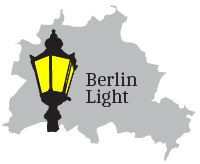The Senate's plan makes only one single comment on the cultural aspects of street lighting. Unfortunately, this comment sounds quite banal: 'Public lighting... forms the cityscape'. In its assessment of Berlin's historical gas street lighting, the Senate entirely neglects all aspects of industrial and cultural history.
Berlin's gas street lighting is unique worldwide. It constitutes a valuable technological and cultural heritage. The gaslight's form and variety has only been preserved through Berlin's especial history.
Such significant cultural heritage must not be sacrificed for the sake of the alleged need to economise.
Scholars consider gaslight as one of the driving forces of the industrial and indeed social revolution of the 19th century. The development and spread of gaslight significantly changed urban everyday culture. In 1826, the first 26 gas street lamps were ignited on the street Unter den Linden. One hundred years later the German capital bore the sobriquet 'Gasopolis'.The city had become the gaslight industry's heartland. Moreover, many innovations in gaslight technology originated in Berlin. The great variety of posts and chandeliers, some over 150 years old, speak of the development of lighting culture. Moving among Berlin's gas street lamps, we are still able to recognize and experience this culture everyday.
Recently an expert report has attested to the heritage significance of Berlin's gas street lighting. In contrast to the Senate's preservation order, this expertise qualifies both the external form and the operational mode of the gas lamps for monument status.
Gaslight forms the cityscape
The typical form and the special, pleasant light of gas lamps form the appearance of many Berlin districts. The majority of Berlin's gas street lamps stand in western districts. The area Frohnau exhibits the highest gas lamp concentration. Ninety-eight percent of the area's streets are gas lit. Additionally, the following areas still contain a lot of gaslights: Zehlendorf, Charlottenburg, Wilmersdorf, Lichterfelde and Lichtenrade. In all of these areas, gas lamps are an integral part of their environment's identity.
Thus, Berlin may lay claim to the unique feature of being a 'Gas street lamp-Metropolis'.
Gas street light as tourist attraction
Although Berlin's gas street lighting constitutes a unique cultural heritage, the city parliament has so far failed to recognise the potential of gas street lighting for tourism.
By contrast, other capitals around the world develop gaslight as a tourist attraction. For example, London offers bus tours themed "Visit London by Gaslight". Moreover, Prague has recently installed 500 new gas lamps on the Charles Bridge and along the historic Coronation Route. Similarly, Warsaw has begun with the installation of gas lamps.
As 'Metropolis of Gas Street Lighting' Berlin has a real chance to develop its existing gas street lamps for tourism; thus, tapping their full economic potential.




 Hängeleuchte
Hängeleuchte Reihenleuchte
Reihenleuchte